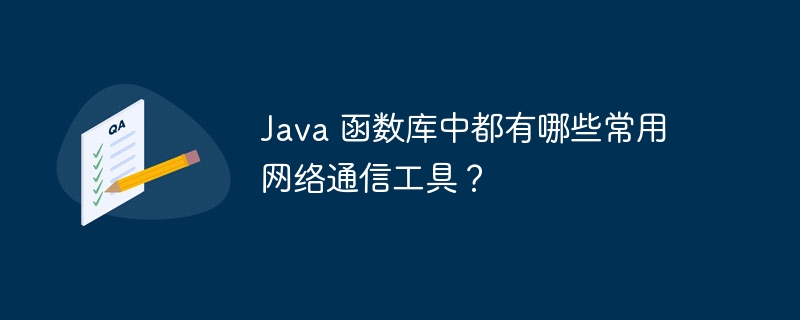Home >Java >javaTutorial >What common network communication tools are included in Java function libraries?
What common network communication tools are included in Java function libraries?
- WBOYWBOYWBOYWBOYWBOYWBOYWBOYWBOYWBOYWBOYWBOYWBOYWBOriginal
- 2024-05-02 21:15:01922browse
The Java function library provides a series of network communication tools, including the java.net package (providing core network classes), the java.nio package (providing high-performance I/O API), and other useful tools (such as Apache HttpClient, Netty and gRPC Java). These tools enable developers to create client and server applications, easily send and receive data, and manage network connections.

Commonly used network communication tools in Java function library
The Java programming language provides a series of powerful function libraries and classes. For building reliable and efficient network communications applications. These tools enable developers to easily communicate between clients and servers, send and receive data, and manage network connections. The following describes some of the most commonly used network communication tools in the Java function library:
java.net package
java.net package contains the Java platform Provided core network communication classes and interfaces. It provides support for TCP/IP sockets, URLs, URIs, and other network infrastructure.
- Socket: Represents an endpoint in network communication and can be used to send and receive data.
- ServerSocket: Represents a server-side socket used to listen for incoming connections.
- URL: Uniform Resource Locator, specifies the address of the network resource.
- URI: Uniform Resource Identifier, used to uniquely identify network resources.
Practical case: Using Socket to create simple clients and servers
// 客户端
import java.net.*;
public class SocketClient {
public static void main(String[] args) throws Exception {
// 创建 Socket 并连接到服务器
Socket socket = new Socket("localhost", 8080);
// 获取输出流并发送消息
DataOutputStream out = new DataOutputStream(socket.getOutputStream());
out.writeUTF("Hello from client!");
// 关闭输出流和 Socket
out.close();
socket.close();
}
}
// 服务器
import java.net.*;
public class SocketServer {
public static void main(String[] args) throws Exception {
// 创建 ServerSocket 并侦听连接
ServerSocket serverSocket = new ServerSocket(8080);
while (true) {
// 接受客户端连接
Socket clientSocket = serverSocket.accept();
// 获取输入流并读取消息
DataInputStream in = new DataInputStream(clientSocket.getInputStream());
String message = in.readUTF();
System.out.println("Received message: " + message);
// 关闭输入流和 Socket
in.close();
clientSocket.close();
}
}
}java.nio package
java.nio The package provides a low-level and high-performance non-blocking I/O API for handling network communication. It provides the following main classes:
- ByteBuffer: Represents a buffer containing raw binary data.
- SelectableChannel: Indicates the IO channel that can be interested in the selector.
- Selector: Used to register and select readable, writable or acceptable channels.
Practical case: Using Selector to write a non-blocking server
// 服务器
import java.net.*;
import java.nio.*;
import java.nio.channels.*;
public class NonBlockingServerSocket {
public static void main(String[] args) throws Exception {
// 创建 ServerSocketChannel 并绑定到端口
ServerSocketChannel serverSocketChannel = ServerSocketChannel.open();
serverSocketChannel.bind(new InetSocketAddress(8080));
serverSocketChannel.configureBlocking(false);
// 创建 Selector 并注册 ServerSocketChannel
Selector selector = Selector.open();
serverSocketChannel.register(selector, SelectionKey.OP_ACCEPT);
while (true) {
// 侦听可用的选择键
int readyKeys = selector.select();
if (readyKeys == 0) {
continue;
}
// 处理可用的选择键
Iterator<SelectionKey> keys = selector.selectedKeys().iterator();
while (keys.hasNext()) {
SelectionKey key = keys.next();
keys.remove();
// 处理可接受的键
if (key.isAcceptable()) {
SocketChannel clientSocketChannel = serverSocketChannel.accept();
clientSocketChannel.configureBlocking(false);
clientSocketChannel.register(selector, SelectionKey.OP_READ);
}
// 处理可读的键
else if (key.isReadable()) {
// ...
}
}
}
}
}Other useful network communication tools
- Apache HttpClient: A feature-rich HTTP client library for sending and receiving HTTP requests.
- Apache HttpClient Async: A non-blocking version of Asynchronous HttpClient that supports asynchronous HTTP communication.
- Netty: A high-performance, event-based network programming framework that supports multiple protocols, including TCP, UDP, and HTTP.
- gRPC Java: A framework for building and serving protobuf-based remote procedure calls.
The above is the detailed content of What common network communication tools are included in Java function libraries?. For more information, please follow other related articles on the PHP Chinese website!

